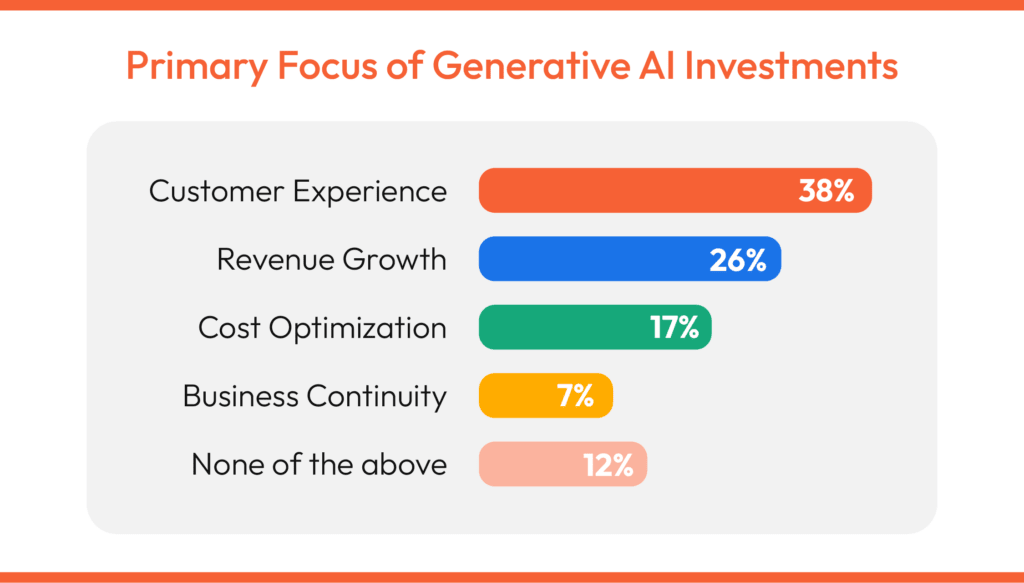To make it in the eCommerce game today, companies need to be savvy with their market research, tech tools, and have a solid business plan. But here’s the secret sauce: creating amazing customer experiences (CX) by building relationships, earning trust, and fostering brand loyalty. And guess what? AI is our trusty sidekick here, helping us personalize, create killer content, and analyze data to up our CX game.
Gartner recently reported that 38% of more than 2,500 executive leaders, set customer experience as the most common primary focus of AI investments. eCommerce operations can significantly improve CX by focusing on the important areas of personalization, content creation, and analysis, all of which can be supported by AI. In the following sections, we take a close look at the many ways in which AI can contribute in these areas.

Source: Gartner, 2023. Poll of more than 2,500 executive leaders.
Expanding Personalization to Increase Positive CX
One way to create a positive CX is to personalize customers’ shopping. “Personalized shopping refers to the process of tailoring shopping experiences to the individual preferences, needs, and behaviors of each customer,” according to an article appearing on Datafloq, a data and technology insights publication.
AI algorithms can analyze data from a variety of sources—including past purchases and browsing activity, social media interactions, and demographic information—to identify patterns and predict shopper preferences. Customers can experience personalization, powered by AI, in a variety of ways:
Personalized landing pages: Customized based on their prior relationship with the site and their shopping habits. For example, a clothing retailer could offer a discount for first-time visitors. Or it could show what’s new in jeans if the person has purchased that item type in the past.
Customized product descriptions: They can be tailored to reflect a shopper’s preferences and habits. Such personalization prompts customers to feel understood, which contributes to greater loyalty and prompts additional purchases.
Personalized recommendations: They can be shown at critical times in the customer journey, such as when they first arrive at the site or when they are about to check out. For example, a “Did you forget?” list presented right before order completion.
Interested in delivering personalized recommendations to your customers? Learn more about our AI Development Services. We’re ready to take you there.
Recently viewed items: This feature displays products the person looked at in previous visits. It is especially useful when shoppers return to a site regularly, so they can easily pick up where they left off during their last session. This feature provides a sense of continuity for customers, which builds trust with the brand.
“Similar to” items: For shoppers who like to compare similar items, the “similar to” feature is helpful. For example, a makeup retailer might display products from the same brand as “similar to” those a shopper has purchased.
Dynamic content: eCommerce retailers can then deliver unique content to each customer segment. These can be highly specific, such as middle-aged, middle-class men who live in Denver and regularly shop for camping supplies. Offers will differ based on segments.
Dynamic pricing: Like dynamic content, it can be tied to users’ demographic information, purchases, and browsing history. It can also be based on other factors, such as time of day, competitor pricing, past sales data, inventory levels, or a combination.
On-site targeting: On-site targeting customizes content using dynamic elements like banners for location-specific announcements and overlays for first-time or exit-intent visitors.
Virtual assistants: They help online shoppers by answering questions, aiding in orders, tracking packages, and personalizing the shopping experience, boosting sales and profits. Watch the video for details on these AI tools.
As AI technology continues to advance, its capabilities for personalization in eCommerce will expand. Eventually, these systems will be able to determine customer intent, use real-time data, and quickly adapt to embrace evolving trends. Also, personalization will be used even more with product recommendations, on-site messages, and user interfaces.
Improving Content Creation to Get Customers Engaged
A second way to create positive CX is to create written, and multimedia content to help customers understand products, get them engaged, and provide them with media to share with others. “AI will significantly change how content marketers create content,” according to an article appearing on IT information publisher Spiceworks. AI tools can help eCommerce operators with the following tasks:
#1 Writing
AI writing tools can generate text for a wide variety of content types, including product descriptions, ad copy, blog posts, and video scripts. To avoid having text seem as though it were “written by a robot,” users can define the tone, target audience, reading level, and more. Marketers can also use AI-generated text as a starting point and add their own polish to it.
#2 Editing
AI-powered editing tools can provide suggestions to improve grammar, readability, check for plagiarism, and adherence to brand parameters. Having these tasks performed by AI-based tools can help organizations cut down on the number of content developers needed.
#3 Repurposing
These tools can also help content developers repurpose content, such as creating an article based on video content, or writing a blog post based on part of an e-book. Such repurposing helps eCommerce operators optimize the effort they put into each content piece.
#4 SEO Research and Keyword Generation
AI tools can help perform some of the most tedious and time-consuming content development tasks, such as SEO research and keyword generation. They can also provide parameters for content, such as ideal word count and questions to include. This use of AI is just one more way for companies to save money on the cost of human labor.
#5 Image generation
Some AI tools were designed specifically to generate images that can be used to accompany text in social media posts, articles, and much more. This feature is helpful because image-based content is more likely to drive engagement than text-only content.
#6 Chatbot text generation
AI tools can help eCommerce operators to create guided conversations between chatbots and customers, make automatic question-and-answer responses, develop natural language response dialogues based on customer questions, and add images, videos, GIFs, buttons, and other visual elements.

#7 General Research
AI tools like ChatGPT can help with the research necessary to provide background information for content. Users can simply ask it questions and get conversational responses based on the information it was trained on.
#8 Content Strategy
For eCommerce services who are not sure where to start with their content development, AI tools are available to create a strategy. It may include keywords to use, types of content to develop, and a schedule for posting content.
#8 Project Management and Planning
Finally, AI tools are available to manage plans and check the effectiveness of keyword-based content. This type of tool may be even more essential as the others allow content teams to increase the volume of development, requiring greater organization.
eCommerce operators should be careful to avoid some of the pitfalls of AI tools to generate content, such as inaccurate information. However, they will find many benefits to using AI tools to help generate promotional content, as follows.
Taking Advantage of Data Analysis to Boost Efficiency and Increase Success
A third way in which eCommerce operators can improve CX with AI is with data analytics. This process can offer invaluable information, including in the following areas.
Pricing Comparisons
Within eCommerce, getting pricing is critical for optimizing revenue and profit, competing with rival companies, and creating strong relationships with customers. AI can take over this research and help eCommerce operations optimize pricing. It can also change prices throughout a site if needed, and help create dynamic pricing, as described above.
Logistics
Some of the biggest causes of customer dissatisfaction are delivery issues, many of which are caused by problems with logistics systems. AI-powered data analysis can help prevent some of these issues by determining product availability, delivery location, and the most efficient delivery routes.
Sales Forecasting
By using historical data in addition to real-time factors such as demographics, weather, and sales performance on similar products, AI-based systems can predict sales. This information is invaluable to eCommerce operators who want to plan ahead for things like spending and inventory replenishment.
Fraud Detection
The more business a site conducts, the greater the likelihood that it will become a victim of fraud. AI can monitor transactions and identify those that appear suspicious. For example, a user might place multiple orders during a brief span of time or use a false address for delivery. AI systems can alert operators of irregular activity.
Inventory
A recent Forbes BRANDVOICE article states, “Retailers can leverage AI-powered inventory management systems for improved stock control, thereby reducing instances of overstock and stockouts and enhancing customer satisfaction.” Such solutions can help eCommerce companies be highly efficient with their inventory spending.
Competitor Activity
Data analysis can be used to gauge competitor activity to help companies make smarter decisions. This analysis includes gathering information from their websites and online assets.
Consumer Trends
AI tools can aggregate data from social media, online forums, news outlets, and other sources to determine popular topics. They can analyze information from customer reviews, social media posts, blogs, and other sources to learn about emerging consumer preferences. They can even segment this information into purchasing habits, demographics, and other information.
Customer Engagement
eCommerce companies with physical stores can analyze customer engagement across POS channels. The information gleaned can be used to provide suggestions for product recommendations, call-to-action messages, and other promotional content to improve customer satisfaction and reduce cart abandonment.
Potential for Unprecedented Success
The introduction of AI into eCommerce operations has created the potential for unprecedented success. One of the most useful aspects of AI solutions in eCommerce is its ability to upgrade the shopping experience for customers, which contributes to greater loyalty and increased sales. Additionally, the ability to analyze vast amounts of data in real-time enables operation leaders to spot emerging trends and pivot, ensuring their companies remain relevant and in demand.
In today’s competitive eCommerce landscape, staying one step ahead is essential for success, and AI is driving that ability. As AI continues to evolve, its potential for transforming eCommerce will increase even more. AI is becoming the foundation upon which all eCommerce operations are built. eCommerce businesses that take full advantage of AI capabilities will continue to survive and thrive with efficient operations, happy customers, and better bottom lines.








